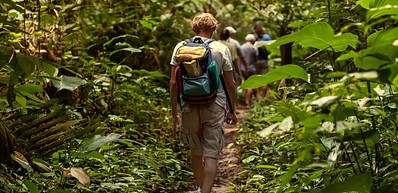
-
![The second lock of the Panama canal from the Pacific ocean.]() Provided by: Galina Savina/Shutterstock.com
Provided by: Galina Savina/Shutterstock.com

Our travel guides are free to read and explore online. If you want to get your own copy, the full travel guide for this destination is available to you offline* to bring along anywhere or print for your trip.
*this will be downloaded as a PDF.Price
€4,95
The Panama Canal
The guide was updated:The Panama Canal is definitely the most important part of the country's infrastructure, both from a strategical and economic point of view.
The Miraflores Visitor’s Center is just a 30 minutes ride from downtown: it has a museum, gift shop, restaurant and observation deck where you can watch the massive ships pass through the locks. It truly is a modern marvel.
In contrast to the more historically and socially focused Museo del Canal Interoceanico, the Miraflores Visitor's Center concentrates on science,
technology and environment behind the functioning of the Canal. The center is worth an afternoon of exploration.
Useful Information
- Opening hours: Mon - Sun (holidays included) from 9h to 16:30h
- Tickets: Nonresidents: adults $15.00, children $10.00, tour operators $12.00
- Website: www.pancanal.com
- Public Transport: You can reach the Miraflores locks by bus or taxi
- Phone: +507 276 8325
Digital Travel Guide Download
Our travel guides are free to read and explore online. If you want to get your own copy, the full travel guide for this destination is available to you offline* to bring along anywhere or print for your trip.
*this will be downloaded as a PDF.Price
€4,95

The Panama Canal is definitely the most important part of the country's infrastructure, both from a strategical and economic point of view.
The Miraflores Visitor’s Center is just a 30 minutes ride from downtown: it has a museum, gift shop, restaurant and observation deck where you can watch the massive ships pass through the locks. It truly is a modern marvel.
In contrast to the more historically and socially focused Museo del Canal Interoceanico, the Miraflores Visitor's Center concentrates on science,
technology and environment behind the functioning of the Canal. The center is worth an afternoon of exploration.
Read more

Casco Antiguo
The historic district of Panama City, keeper of the city's traditions and history, is characterized by charming narrow streets, colorful buildings, exciting cultural attractions and an array of hotels, cafes, bars, nightclubs, restaurants and art galleries. No wonder people are coming from all over the world to visit this evocative little corner of the world.
In 1673, after the sacking of Panama Viejo by Welsh privateer Henry Morgan, the current Casco Antiguo was chosen as location to rebuild Panama’s capital city. The new city was surrounded by a wall to protect it from further pillaging. An eclectic blend of French, Spanish and American architecture developed as the country evolved over the years.
Read more

Panama Viejo
UNESCO World Heritage Site Panama La Vieja, commonly known as Panama Viejo, is the site where Pedro Arias de Dávila originally founded the old Panama City, back in 1519. This was the first Spanish settlement on the Pacific coast of the Americas.
Nowadays you can visit all that remains of the ancient settlement, which was burned down in 1671, by going in the eastern side of Panama City.
Since most of the original city was made of wood, the ruins are not that extensive, but they are well-preserved and make for an interesting visit.
The Visitor Center at Panama La Vieja has a collection of archaeological findings and information about the history of this invaluable place.
Read more

The Biomuseo
Eight distinctive pavilions, eight permanent exhibitions designed to narrate the origins of the Panamanian isthmus and its huge impact on the planet's biodiversity.
The Biomuseo is designed to lead visitors on an amazing journey of discovery and the interactive exhibits created by "Bruce Mau Design" make this museum even more astonishing. Once inside you can admire colored glass murals, giant screens, towering geological cross-sections of the isthmus, life-sized animal sculptures, multi-storied aquaria and even more!
The building itself is an architectural icon designed by Frank Gehry.
Read more

The Fish Market
Come try the local seafood excellence at the Panama City Fish Market: lobsters, king crabs, octopuses, shrimps and many other products at excellent prices. Here you can also try different kind of ceviche (fish or seafood cooked in lime juice) together with a fresh beer, the perfect beverage to go with it.
What are you waiting for, we all know there isn't a better way to get in touch with another culture than by tasting the local dishes!
Read more

Jungle Land Panama
Eco Tours and Overnight Adventures:
Discover the most unique and complete all-inclusive experience at the only floating lodge in Panama City! Explore the Canal from within and live the real Jungle Experience.
Read more

Panama Rainforest Discovery Center
With almost 1000 birds species and a unique natural diversity, Panama is the perfect spot for bird-watching and wild nature enthusiasts. The Soberania National Park, 30 minutes away from Panama City, offers a great opportunity for discovering the country's flora and fauna. The Panama Rainforest Discovery Center, located inside the National park, offers a 1.1 kilometer circuit of trails through the forest and a 32 meters tall observation tower, from which to observe the vast rain forest.
Take part in a unique journey, lose yourself in the lush tropical jungle, explore, discover, learn.
Read more

Inter-Oceanic Canal Muesum
Still undecided about which museums to visit while in Panama City? Worry no more, because you have found the one you can't miss. With 10 permanent exhibitions that trace the construction of the Panama Canal and its impact on Panamanian history and society, the museum deserves at least a couple of hours in order to appreciate and absorb the wealth of information available.
The museum highlights include the 1977 Carter-Torrijos Treaty that marked the end of the American control over the Panama Canal, as well as several interactive and engaging exhibits.
Guided tours are available in both Spanish and English to help you navigate through the abundant information.
Read more

Museo Antropologico Reina Torres De Arauz
Its collection of 15,000 pre-Columbian ceramic, sandstone and ethnographic pieces is by far the largest grouping of anthropocentric historical artifacts in Panama City. The M.A.R.T.A. is one of the most important museum in the country, keeper of its most ancient history and traditions. Come visit to admire pre-Columbian treasures and indigenous artifacts, as well as household items and farm tools demonstrating modern Panamanian life and culture.
Read more

Visit an Indigenous Tribe
Discover the fascinating, timeless lifestyle of the Embera indigenous tribe, an ethnic minority who survived the arrival of the conquistadors and continues to exist today. Embark on a canoe trip along the Chagres river, through the lush tropical rain forest and learn about their culture, everyday life and traditions. The Embera people are famous for their basketry and woodwork, among other handicrafts. This is one of the best experiences you can have while visiting Panama City.
Read more

Ancon Hill
A scenic overlook in Panama City, 654 feet above sea level. Enjoy a pleasant hike to the top of the hill, along a paved road and escorted by exotic birds and wildlife. You can also reach the top by car and take amazing shots of the Panama Canal, the modern city and the Casco Antiguo.
The Panamanian flag sits at the top of the hill as a symbol of pride and sovereignty: before 1977 Ancon Hill was under US jurisdiction and Panamanians did not have access to it.
At the bottom of the hill resides a site called “Mi Pueblito” (my little town), a small colorful museum-like installation depicting the culture, traditions and architecture of Panama as well as its Hispanic, indigenous and Afro-Antillean heritage.
Read more

Amador Causeway
The causeway is a long stretch of land uniting the mainland with four small islands. It was created using the materials removed during the construction of the canal.
The Amador Causeway is now developing into a great tourist spot, both during the day and the night, thanks to a lively scene of street cafes, restaurants and bars. There are excellent views of the city skyline and the Casco Viejo. A firm favorite with families, the causeway’s wide sidewalks are great for walking, jogging and cycling. The Smithsonian Research Institute is also on the Causeway and is well worth a visit.
Read more

Shopping
Panama is a paradise for shopping lovers, home to the largest malls in Central America.
The smallest of them is the MultiPlaza Pacifica, located in Punta Pacifica: it is home to many chic designer stores as well as facilities such as banks, making this a convenient one-stop shopping location.
MultiCentro mall on Avenida Balboa is also a high-end shopping destination.
The largest of all is Albrook Mall, located next to the domestic airport. Albrook is home to some of the least expensive shops in Panama, as well as the main international chains and high-end stores.
All these malls have movie theaters and food courts.
Aside from the malls, a good selection of stores can be found on Via España, close to the banking district. Whereas If you are looking for a true bargain, Avenida Central in Calidonia provides quite an intense shopping experience, particularly for household goods and appliances.
Read more

Nightlife
Panama City has everything you are looking for when it comes to nightlife. Whether you are here on business, for leisure, with the family, or just exploring the city by yourself, you can’t miss out on Panama’s nightlife. You will find everything from dress-down breweries to stylish nightclubs in the heart of the city and a rooftop bar with spectacular views.
Read more

Bird Watching
Panama City is one of the few modern cities in the world that lie less than 30 minutes away from the tropical virgin jungle. The Pipeline Road has earned the Audubon Society's World Record for most bird species spotted in 24 hours! Among the species, you can see Passerini’s Tanager and Resplendent Quetzals, as well as South American species such as the Flame-rumped Tanager and Golden-headed Quetzal.
Read more


